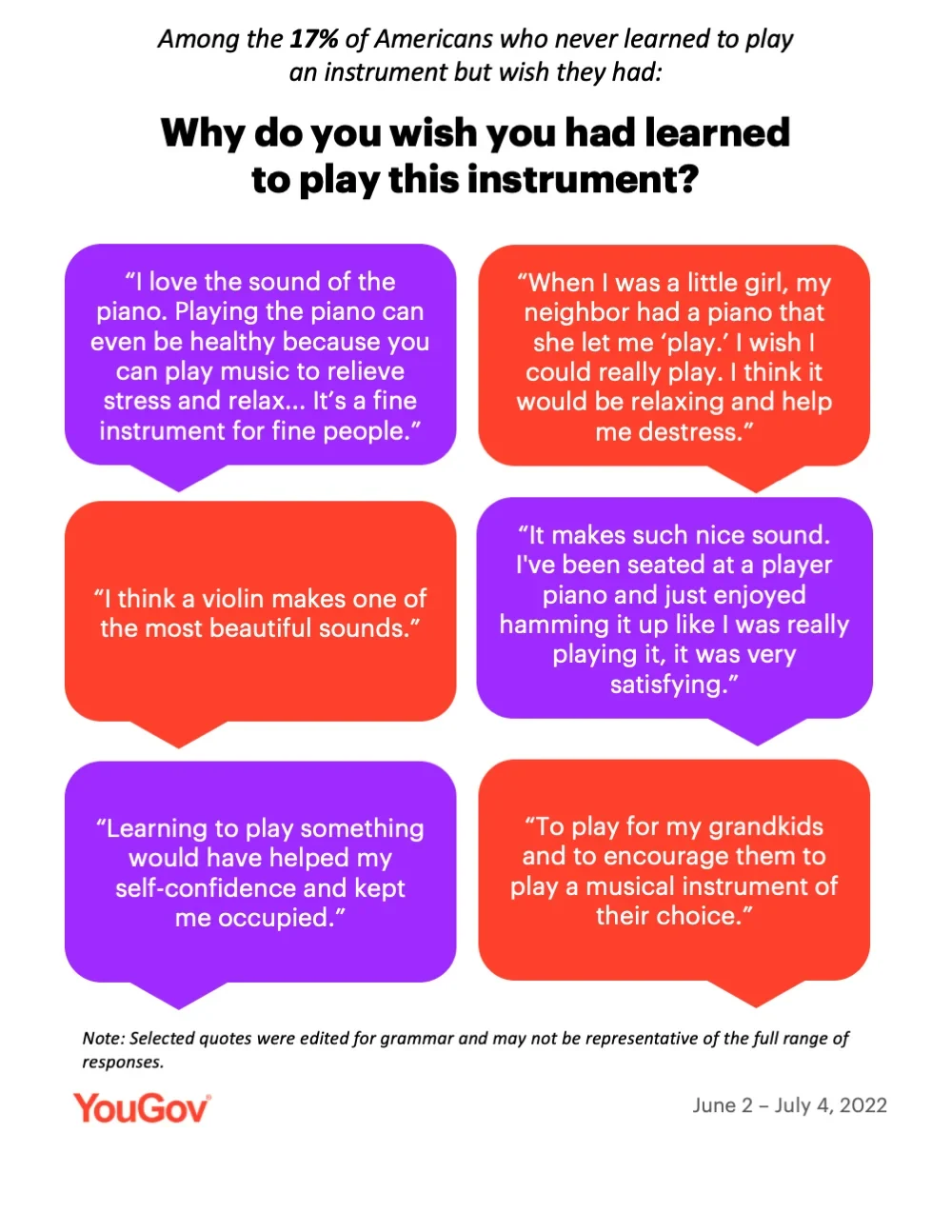Musical instruments have played a part in many Americans' lives — with younger adults even more acquainted with playing a variety of instruments than the generations before them are.
A series of YouGov surveys of 3,000 U.S. adult citizens asked about people’s experience with musical instruments throughout their lifetime, regardless of whether they still played music. The results show that two-thirds of Americans (66%) have learned to play a musical instrument at some point in their lives, with younger adults (71%) even more likely than older adults to have played some sort of musical device.
While younger Americans are increasingly introduced to playing a wide range of instruments, there are some instruments that are particularly common among certain age groups. Adults over 65, for instance, are especially likely to have learned to play the piano (37%) compared to younger age groups. The guitar is more common among 18-to 29-year-olds (23%) than among any other age group — and the same goes for electric guitar and drums. Younger Americans also are more likely than older Americans to be familiar with the recorder, which is now commonly used in U.S. schools to introduce children to a simple, affordable instrument.
Playing musical instruments does not come naturally to many people
Playing music is a challenge for many, though it appears to come more naturally to people who started playing an instrument earlier in life. Half of Americans who have played instruments (50%) say that it’s not something that comes naturally to them, while just over one-third (36%) say it does. Only 9% of musicians say that they first started playing an instrument at age 5 or younger, but more than half of those early starters (52%) say that playing an instrument comes naturally.
About half of Americans who have played instruments (48%) started playing one between ages 6 to 10, while one-third (33%) began between the ages of 11 and 17. Just 9% say they first were introduced to playing an instrument at 18 or older. People who were introduced to performing music later in life are more likely to say it “does not come naturally” to them. People who generally play by ear (without reading sheet music) are more likely to say that playing music “does come naturally” to them (56%) than are people who play by freestyling (45%) or by reading sheet music (35%).
How Americans learn to play popular musical instruments
Among the most commonly played instruments (defined as those where 100 or more people in the poll had played each), certain instruments are more commonly self-taught, while others are more typically learned from lessons or a class.
Nearly two-thirds of people who play the harmonica (65%) or ukulele (62%) say they were self-taught. Electric variations of popular instruments — like the electric guitar (52%), electric piano (50%), and electric bass (50%) — are also more likely to be self-taught than learned through informal or formal lessons. For people who play drums or guitar, there are more varied methods of learning. About half of drummers (47%) learned by teaching themselves, with 27% learning from lessons or a class and 24% learning through informal lessons. Guitar players are about equally likely to have taken a class (39%) as to be self-taught (36%), while 25% learn informally.
Other instruments were learned through lessons or a class for a majority of players, such as clarinet (73%), recorder (70%), trumpet (66%), saxophone (63%), flute (62%), piano (60%), and violin (59%).
Most Americans who have played an instrument at some point in their life were either encouraged (50%) or required (14%) by their parents to do so. Americans who have played piano are more likely than musicians overall to say that their parents made them play some type of instrument (21% for Americans who played piano, 14% for musicians overall). A majority of musicians who are 45 and older say that their parents encouraged them to play an instrument but did not require it. Fewer than half of adults under 45 say the same.
What instruments are Americans still playing, and who regrets quitting?
Though two-thirds of American adults have experience playing a musical instrument at some point in their lives, many no longer do. There is no instrument for which a clear majority of people who have played it at some point have stuck with it to this day — though electronic instruments such as the electric bass, electric guitar, and electric piano have the highest levels of continued playing. Popular string instruments, such as the guitar and ukulele, also have comparatively high rates for continued playing.
People who played and subsequently quit playing the electric guitar (55%), guitar (51%), and piano (48%) are the most likely former musicians to regret quitting. That's among a subset of instruments with enough people in the sample who played them and then quit. The lowest level of regret for quitting, among instruments with enough data, is for the recorder: 88% of people who played the recorder at some point have no regret about quitting the K-12 music-class staple.
Many Americans who never played an instrument wish they had
Among the one-third of Americans (34%) who have never learned to play an instrument, about half wish that they had (which comes out to 17% of Americans). When asked which instrument they most wish they knew how to play, many of these aspiring musicians list the most popular instruments: the piano (47%), guitar (22%), or drums (8%).
Their reasons for wishing they had picked up an instrument include wanting to fulfill a lifelong dream and simply appreciating the music it makes. Asked in an open-ended question about why they wish they had learned an instrument, many wrote about how they believe it would have benefited them in life, how much they love the sound that a particular instrument makes, or that it simply seems like an enjoyable hobby.

— Carl Bialik, Taylor Orth, and Joe Williams contributed to this article
This poll was conducted in three waves on three separate surveys conducted from June 29 - July 4, 2022, June 6 - 9, 2022, and June 2 - 5, 2022, among 3,000 U.S. adult citizens. Explore more on the methodology and data for this poll.
Image: Adobe Stock by Minerva Studio











